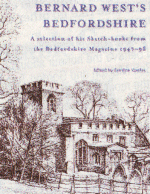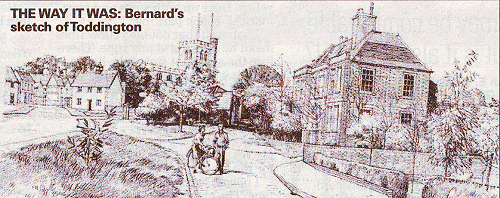Back to the drawing board
Posted on December 14, 2007
Sharp observations and striking sketches of Bedfordshire, by the late Bernard West, have now been gathered together in a new book.
 The architect contributed his Sketch-book, of drawings and comment, to the quarterly former Bedfordshire Magazine for half a century.
The architect contributed his Sketch-book, of drawings and comment, to the quarterly former Bedfordshire Magazine for half a century.
He was passionate about his native county and shared his detailed knowledge of architecture and the history of Bedfordshire in his writings.
Bernard was also interested in archaeology, natural history and the conservation of both the natural, and the best of the man-made, environment.
His commentaries were often scathing as he continued his unrelenting campaign for good design and sympathetic preservation.
Now The Book Castle, in Dunstable, has published a fascinating selection of his work from the Bedfordshire Magazine, from 1947-1998.
Bernard West's Bedfordshire, edited by Gordon Vowles, contains sketches and comment on areas around the county.
In the editor's foreword, Gordon writes: "In his Sketch-book commentaries, he was a persistent and caustic critic of those who, in his own words, were 'guilty of inducing in others an anaesthetic acceptance of ugliness'."
Bernard died in January last year, and the book sets out to mark his unique contribution to the record of 20th century Bedfordshire life.
The selection of writings includes a section on Dunstable, written in spring 1995.
Bernard said the town centre nowadays belied its antiquity. He could remember something of its character surviving until the immediate pre-war years, "when the dreadful suburban tentacle from the west side of Luton began to engulf the old town".
High Street North kept a little of its character, he said, particularly around the Sugar Loaf Hotel.
It was, however, High Street South which preserved something of the character of old Dunstable.
Bernard talked of H.J. Massingham's reference, in his Chiltern Country, to "suburbanisation", and said that Dunstable was a monument to the result of this process.
He concluded: "There are indications that we have learnt lessons from the dreadful mistakes of the 1960s, that we are discovering a new urbanity, but it is a bit late for Dunstable to benefit."
In spring 1980, he wrote a scathing comment on Eaton Bray.
"As a county, we have worse body sores than Eaton Bray, but the spreading tattiness is unbearable in what is still a semi-rural setting.
"Tilsworth suffers from it, so do parts of Totternhoe and Stanbridge, and one wonders how and why the much vaunted planning control of the last 30 years has so utterly failed to hold these villages of the plain in some sort of order," he wrote.
Barton is among the other villages featured in the book.
In the summer of 1977, Bernard wrote: 'At Barton, the estates spread along the Higham Gobion road have become a textbook example of failure in planning control, but behind them is a precarious survival: the church, a magnificent partly moated rectory and various 18th century cottages.
"Some are in the usual fancy dress, and one in the foreground of the illustration is sorely in need of repair, but we must be grateful that it is still possible to walk from here onto downland, and still feel the relationship of the spring-line village with the hills beyond."

In 1955, Bernard described Toddington as one of the most urbane of the county's villages, perhaps because it had the status of a market town in the past.
He said that by 1800, its importance was waning, but the air of prosperity still lingered, "and the grouping of the buildings around the central greens is one of the most satisfying in the county".
The fine Georgian house in his illustration had been restored in recent years, and he said it was to the lasting credit of those responsible that the old village pond alongside had been converted so imaginatively "into a little gem of free garden planning".
He said: "There are no formal flower beds or railings, or the kind of suburban picturesque treatment that the Architectural Review so wittily calls 'God wottery'. The site is subtly contoured, the planting is informal, and the result is a complete delight.
"But is it not strange that a community which can create something so pleasing should tolerate such an abortion as the petrol sign in the middle of the green? The pumps and the garage itself, although utilitarian, are quite innocuous, but the sign sticks out like a sore thumb from all viewpoints. I have deliberately toned it down in the drawing.
"Surely the much vaunted Town and Country Planning Act could control this kind of thing? It can be harsh enough on the private builder and, rightly, on advertisements in towns; but out in the country it permits advertising and its attendant evils to riot unchecked."
Bernard West's Bedfordshire is published in paperback by The Book Castle, Church Street, Dunstable, price £12.99.
Source: Anne O'Donoghue, Dunstable Gazette, 12 December 2007
Reader Comments
December 18, 2007
,Eaton Bray says:You can find more historical information about the village on the Eaton Bray History pages.